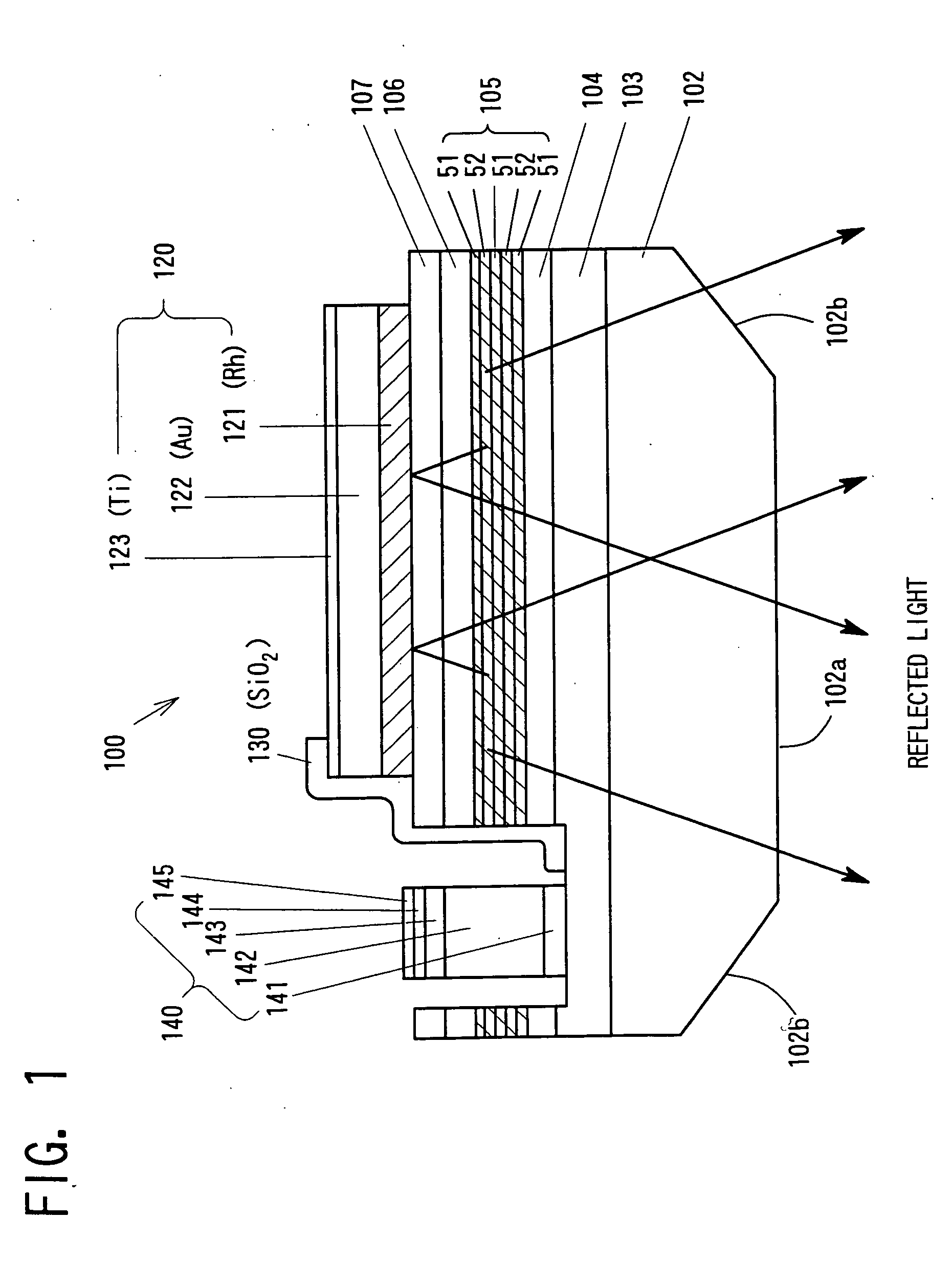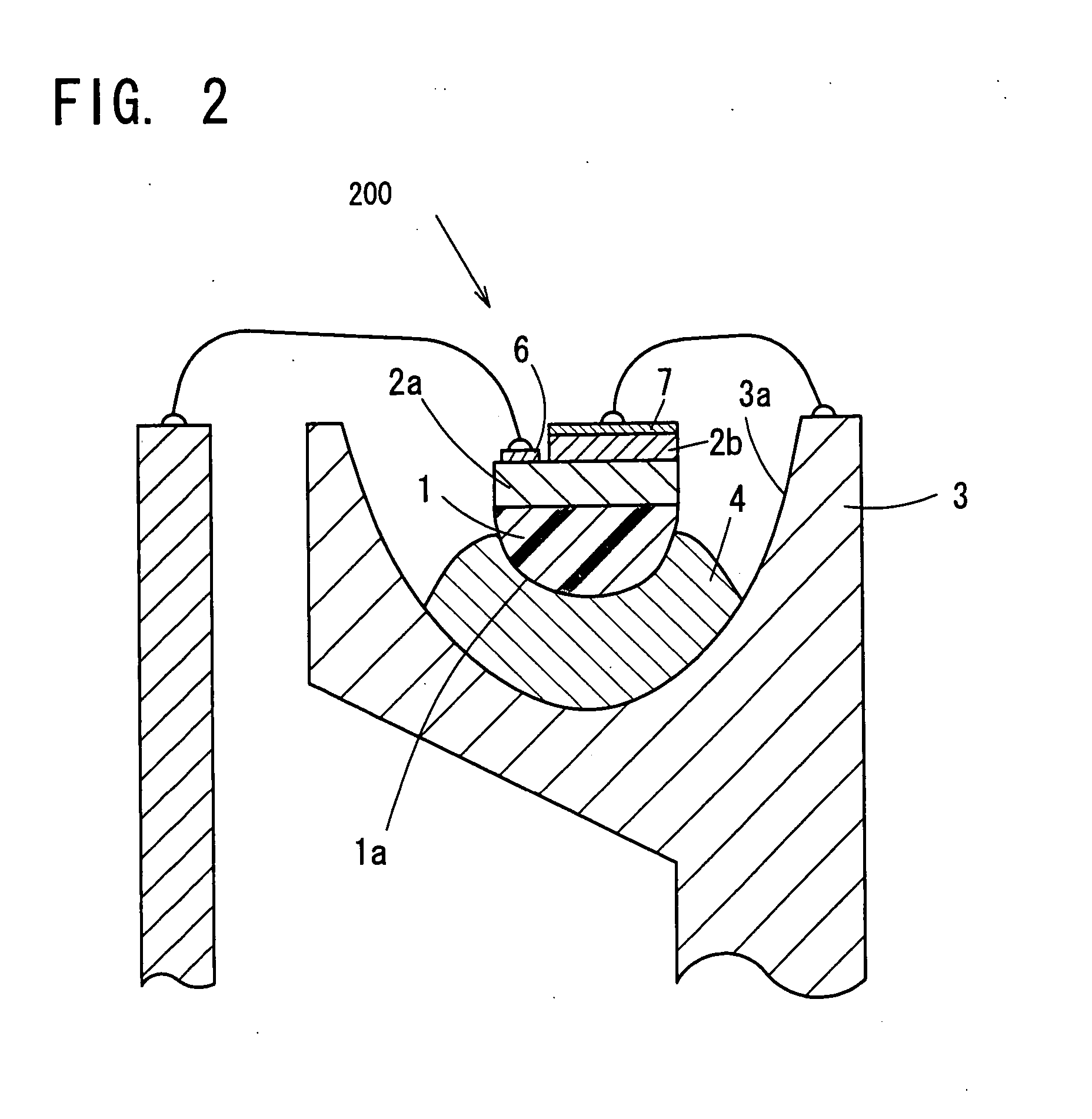Light-emitting diode and process for producing the same
a technology of light-emitting diodes and diodes, which is applied in the direction of basic electric elements, electrical apparatus, semiconductor devices, etc., can solve the problems of difficult to divide semiconductor wafers, difficult grinding process, and easy breakage of the substrate itself, so as to improve the external quantum efficiency and luminous extracting efficiency of the light-emitting diodes. , the effect of improving the external quantum efficiency and luminous extracting efficiency
- Summary
- Abstract
- Description
- Claims
- Application Information
AI Technical Summary
Benefits of technology
Problems solved by technology
Method used
Image
Examples
embodiment 1
[0101]FIG. 1 is a sectional view of a face-down type light-emitting diode 100 of the present embodiment. The back surface of a semiconductor crystal substrate 102 which has a thickness of about 150 μm and is made of undoped GaN bulk crystal comprises a polished plane 102a which is flattened through dry-etching and a polished plane 102b which is formed in a taper shape and is flattened through dry-etching. As a crystal growth plane which is almost parallel to the polished plane 102a of the semiconductor crystal substrate 102, c plane of the GaN bulk crystal is applied. About 4.0 μm in thickness of silicon (Si) doped gallium nitride (GaN) n-type contact layer 103 is deposited through crystal growth on the crystal growth plane.
[0102] The n-type contact layer 103 has an impurity (Si) concentration of about 1×1019 / cm3. About 10 nm in thickness of GaN n-type clad layer (low carrier concentration layer) 104 is formed on the n-type contact layer 103.
[0103] On the n-type clad layer 104, ab...
second embodiment
[0164] In a process of forming dividing grooves by applying laser irradiation, a fused and re-solidified material, which is a material of a semiconductor fused by laser irradiation heat, and a fused, scattered and re-solidified material, which is a material fused and scattered in a chamber and then adhered and solidified there, tend to be left at the sidewalls and the back surface of the device. Such fused and re-solidified material and fused, scattered and re-solidified material may preferably be removed through blast treatment and so on considering external quantum efficiency and luminous extracting efficiency. Even by employing such blasting treatment, however, a physically damaged layer as in the first embodiment may be formed owing to some conditions of the treatment. Accordingly, the present invention is also useful for a device in which the physically damaged layer is formed through blasting treatment.
[0165]FIG. 2 is a sectional view of a face-up type light-emitting diode 20...
third embodiment
[0169] In the first embodiment, the taper part is formed at the semiconductor crystal substrate 102. Alternatively, the taper part for extracting light may be formed at the sidewall of each semiconductor layer (103-107) deposited through crystal growth to face to the surface of the wafer. The taper part deposited on formed on the side wall near the surface of semiconductor layers functioning as a device also contributes to improve luminous extracting efficiency and external quantum efficiency. A similar taper part tends to be formed at the surface of the wafer when a V-shaped groove for dividing chip is formed on the surface of the wafer. These taper parts can be formed by using, for example, a dicing cutter. And the etching treatment (finishing treatment) is useful for each of thus-obtained taper parts.
[0170] Such characteristics are explained in the third embodiment.
[0171]FIG. 3 is a sectional view of a face-up type light-emitting diode 1000 in the third embodiment of the presen...
PUM
 Login to View More
Login to View More Abstract
Description
Claims
Application Information
 Login to View More
Login to View More - R&D
- Intellectual Property
- Life Sciences
- Materials
- Tech Scout
- Unparalleled Data Quality
- Higher Quality Content
- 60% Fewer Hallucinations
Browse by: Latest US Patents, China's latest patents, Technical Efficacy Thesaurus, Application Domain, Technology Topic, Popular Technical Reports.
© 2025 PatSnap. All rights reserved.Legal|Privacy policy|Modern Slavery Act Transparency Statement|Sitemap|About US| Contact US: help@patsnap.com



